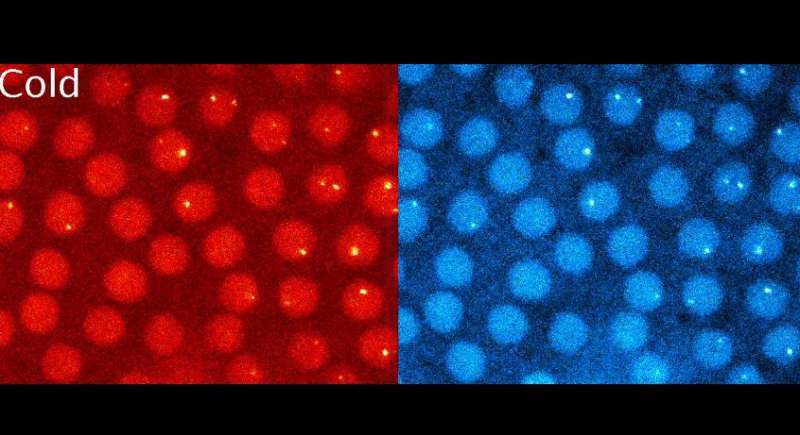Nucleolus forms via combination of active and passive processes

Researchers at Princeton found that the nucleolus, a cellular organelle involved in RNA synthesis, assembles in part through the passive process of phase separation – the same type of process that causes oil to separate from water. The study, published in the journal Proceedings of the National Academy of Sciences, is the first to show that this happens in living, intact cells.
Understanding how cellular structures form could help explain how organelles change in response to diseases. For example, a hallmark of cancer cells is the swelling of the nucleolus.
To explore the role of passive processes – as opposed to active processes that involve energy consumption – in nucleolus formation, Hanieh Falahati, a graduate student in Princeton's Lewis-Sigler Institute for Integrative Genomics, looked at the behavior of six nucleolus proteins under different temperature conditions. Phase separation is enhanced at lower temperatures, which is why salad dressing containing oil and vinegar separates when stored in the refrigerator. If phase separation were driving the assembly of proteins, the researchers should see the effect at low temperatures.
Falahati showed that four of the six proteins condensed and assembled into the nucleolus at low temperatures and reverted when the temperature rose, indicating that the passive process of phase separation was at work. However, the assembly of the other two proteins was irreversible, indicating that active processes were in play.
"It was kind of a surprising result, and it shows that cells can take advantage of spontaneous processes for some functions, but for other things, active processes may give the cell more control," said Falahati, whose adviser is Eric Wieschaus, Princeton's Squibb Professor in Molecular Biology and a professor of molecular biology and the Lewis-Sigler Institute for Integrative Genomics, and a Howard Hughes Medical Institute researcher.
The study, "Independent active and thermodynamic processes govern the nucleolus assembly in vivo," by Hanieh Falahatia and Eric Wieschaus, was published online ahead of print in the journal Proceedings of the National Academy of Sciences on January 23, 2017.
More information: Hanieh Falahati et al. Independent active and thermodynamic processes govern the nucleolus assembly in vivo, Proceedings of the National Academy of Sciences (2017). DOI: 10.1073/pnas.1615395114
Journal information: Proceedings of the National Academy of Sciences
Provided by Princeton University



















